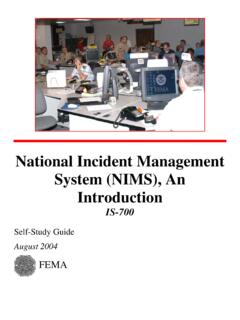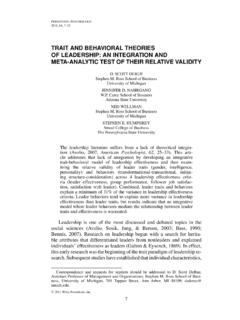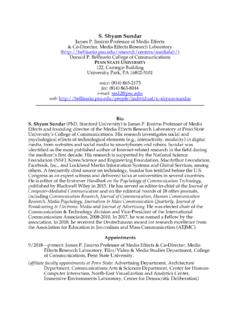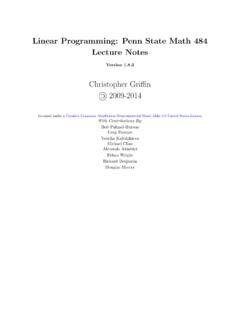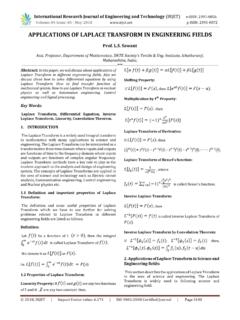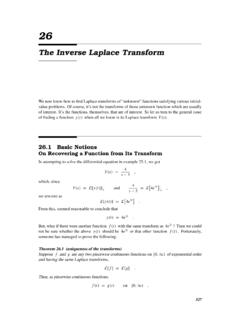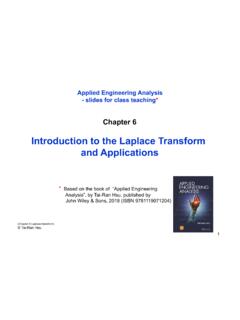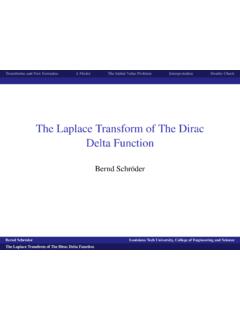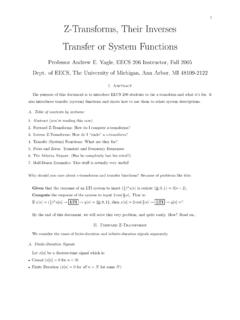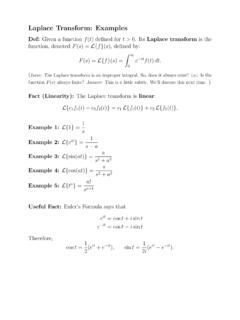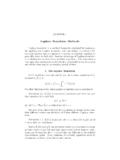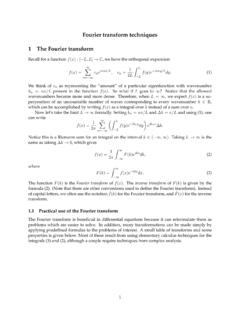Transcription of Lecture Notes for Laplace Transform
1 Lecture Notes for Laplace TransformWen ShenApril 2009NB! These Notes are used by myself. They are provided to students as a supplement to thetextbook. They can not substitute the textbook. Laplace Transform is used to handle piecewise continuous or impulsive : Definition of the Laplace Transform (1)Topics: Definition of Laplace Transform , Compute Laplace Transform by definition, including piecewise continuous :Given a functionf(t),t 0, its Laplace transformF(s) =L{f(t)}is defined asF(s) =L{f(t)}.= 0e stf(t) limA A0e stf(t)dtWe say the Transform converges if the limit exists, and diverges if we will give examples on computing the Laplace Transform of given functions by (t) = 1 fort (s) =L{f(t)}= limA A0e st 1dt= limA 1se st A0= limA 1s[e sA 1]=1s,(s >0) (t) = (s) =L{f(t)}= limA A0e steatdt= limA A0e (s a)tdt= limA 1s ae (s a)t A0= limA 1s a(e (s a)A 1)=1s a,(s > a) (t) =tn, forn 1 (s) = limA A0e sttndt= limA {tne st s A0 A0ntn 1e st sdt}= 0 +nslimA A0e sttn 1dt=nsL{tn 1}.
2 So we get a recursive relationL{tn}=nsL{tn 1}, n,which meansL{tn 1}=n 1sL{tn 2},L{tn 2}=n 2sL{tn 3}, By induction, we getL{tn}=nsL{tn 1}=ns(n 1)sL{tn 2}=ns(n 1)s(n 2)sL{tn 3}= =ns(n 1)s(n 2)s 1sL{1}=n!sn1s=n!sn+1,(s >0)Example4. Find the Laplace Transform of sinatand 1. Compute by definition, with integration-by-parts, twice. (lots of )Method 2. Use the Euler s formulaeiat= cosat+isinat, L{eiat}=L{cosat}+iL{sinat}.By Example 2 we haveL{eiat}=1s ia=1(s+ia)(s ia)(s+ia)=s+ias2+a2=ss2+a2+ias2+ the real and imaginary parts, we getL{cosat}=ss2+a2,L{sinat}=as2+a2,(s >0).Remark: Now we will use 0instead of limA A0, without causing piecewise continuous functions, Laplace Transform can be computed by integrating eachintegral and add up at the Find the Laplace Transform off(t) ={1,0 t <2,t 2,2 do this by definition:F(s) = 0e stf(t)dt= 20e stdt+ 2(t 2)e stdt=1 se st 2t=0+ (t 2)1 se st t=2 A21 se stdt=1 s(e 2s 1) + (0 0) +1s1 se st t=2=1 s(e 2s 1) +1s2e : Solution of initial value problems (4)Topics.}
3 Properties of Laplace Transform , with proofs and examples Inverse Laplace Transform , with examples, review of partial fraction, Solution of initial value problems, with examples covering various of Laplace :L{c1f(t) +c2g(t)}=c1L{f(t)}+c2L{g(t)}. derivative:L{f (t)}=sL{f(t)} f(0). derivative:L{f (t)}=s2L{f(t)} sf(0) f (0). order derivative:L{f(n)(t)}=snL{f(t)} sn 1f(0) sn 2f (0) sf(n 2)(0) f(n 1)(0). { tf(t)}=F (s) whereF(s) =L{f(t)}. This also impliesL{tf(t)}= F (s). {eatf(t)}=F(s a) whereF(s) =L{f(t)}. This implieseatf(t) =L 1{F(s a)}.Remarks: Note property 2 and 3 are useful in differential equations.
4 It shows that each derivativeintcaused a multiplication ofsin the Laplace Transform . Property 5 is the counter part for Property 2. It shows that each derivative inscausesa multiplication of tin the inverse Laplace Transform . Property 6 is also known as the Shift Theorem. A counter part of it will come later inchapter follows by definitionL{f (t)}= 0e stf (t)dt=e stf(t) 0 0( s)e stf(t)dt= f(0) +sL{f(t)}. one follows from Property 2. Setfto bef we getL{f (t)}=sL{f (t)} f (0) =s(sL{f(t)} f(0)) f (0) =s2L{f(t)} sf(0) f (0). follows by induction, using property proof follows from the definition:F (s) =dds 0e stf(t)dt= 0 s(e st)f(t)dt= 0( t)e stf(t)dt=L{ tf(t)}.
5 Proof also follows from definition:L{eatf(t)} 0e steatf(t)dt= 0e (s a)tf(t)dt=F(s a).By using these properties, we could find more easily Laplace transforms of many other {tn}=n!sn+1,we getL{eattn}=n!(s a)n+ {sinbt}=bs2+b2,we getL{eatsinbt}=b(s a)2+ {cosbt}=ss2+b2,we getL{eatcosbt}=s a(s a)2+ {t3+ 5t 2}=L{t3}+ 5L{t} 2L{1}=3!s4+ 51s2 {e2t(t3+ 5t 2)}=3!(s 2)4+ 51(s 2)2 21s {(t2+ 4)e2t e tcost}=2(s 2)3+4s 2 s+ 1(s+ 1)2+ 1,becauseL{t2+ 4}=2s3+4s, L{(t2+ 4)e2t}=2(s 2)3+4s are a few examples for Property {eat}=1s a,we getL{teat}= (1s a) =1(s a) {tsinbt}= (bs2+b2) = 2bs(s2+b2) {tcosbt}= (ss2+b2) = =s2 b2(s2+b2) Laplace Transform .
6 Definition:L 1{F(s)}=f(t),ifF(s) =L{f(t)}.Technique: find the way simple 1{3s2+ 4}=L 1{32 2s2+ 22}=32L 1{2s2+ 22}=32sin 1{2(s+ 5)4}=L 1{13 6(s+ 5)4}=13L 1{3!(s+ 5)4}=13e 5tL 1{3!s4}=13e 1{s+ 1s2+ 4}=L 1{ss2+ 4}+12L 1{2s2+ 4}= cos 2t12sin 1{s+ 1s2 4}=L 1{s+ 1(s 2)(s+ 2)}=L 1{3/4s 2+1/4s+ 2}=34e2t+14e we used partial fraction to find out:s+ 1(s 2)(s+ 2)=As 2+Bs+ 2,A= 3/4, B= 1 of initial value will go through one example (Two distinct real roots.) Solve the initial value problem by Laplace Transform ,y 3y 10y= 2,y(0) = 1, y (0) = 1. Take Laplace Transform on both sides: LetL{y(t)}=Y(s), and thenL{y (t)}=sY(s) y(0) =sY 1,L{y (t)}=s2Y(s) sy(0) y (0) =s2Y s the initial conditions are the first thing to go in!
7 L{y (t)} 3L{y (t)} 10L{y(t)}=L{2}, s2Y s 2 3(sY 1) 10Y= we get an algebraic equation forY(s).Step 2: Solve it forY(s):(s2 3s 10)Y(s) =2s+s+ 2 3 =s2 s+ 2s, Y(s) =s2 s+ 2s(s 5)(s+ 2).Step 3: Take inverse Laplace Transform to gety(t) =L 1{Y(s)}. The main technique here ispartial (s) =s2 s+ 2s(s 5)(s+ 2)=As+Bs 5+Cs+ 2=A(s 5)(s+ 2) +Bs(s+ 2) +Cs(s 5)s(s 5)(s+ 2).Compare the numerators:s2 s+ 2 =A(s 5)(s+ 2) +Bs(s+ 2) +Cs(s 5).The previous equation holds for all values 0: we get 10A= 2, soA= 5: we get 35B= 22, soB= 2: we get 14C= 8, soC= ,Y(s) is written into sum of terms which we can find the inverse Transform :y(t) =AL 1{1s}+BL 1{1s 5}+CL 1{1s+ 2}= 15+2235e5t+47e of solutions: Take Laplace Transform on both sides.
8 You will get an algebraic equation forY. Solve this equation to getY(s). Take inverse Transform to gety(t) =L 1{y}.Example15. (Distinct real roots, but one matches the source term.) Solve the initial valueproblem by Laplace Transform ,y y 2y=e2t,y(0) = 0, y (0) = Laplace Transform on both sides of the equation, we getL{y } L{y } L{2y}=L{e2t}, s2Y(s) 1 sY(s) 2Y(s) =1s it forY:(s2 s 2)Y(s) =1s 2+1 =s 1s 2, Y(s) =s 1(s 2)(s2 s 2)=s 1(s 2)2(s+ 1).Use partial fraction:s 1(s 2)2(s+ 1)=As+ 1+Bs 2+C(s 2) the numerators:s 1 =A(s 2)2+B(s+ 1)(s 2) +C(s+ 1)Sets= 1, we getA= 29. Sets= 2, we getC=13. Sets= 0 (any convenient values ofscan be used in this step), we getB=29.
9 SoY(s) = 291s+ 1+291s 2+131(s 2)2andy(t) =L 1{Y}= 29e t+29e2t+ this to the method of undetermined coefficient: general solution of the equationshould bey=yH+Y, whereyHis the general solution to the homogeneous equation andYis a particular solution. The characteristic equation isr2 r 2 = (r+ 1)(r 2) = 0,sor1= 1, r2= 2, andyH=c1e t+c2e2t. Since 2 is a root, so the form of the particularsolution isY=Ate2t. This discussion concludes that the solution should be of the formy=c1e t+c2e2t+Ate2tfor some constantsc1, c2, A. This fits well with our (Complex roots.)y 2y + 2y=e t, y(0) = 0, y (0) = we solve it, let s use the method of undetermined coefficients to find out which termswill be in the 2r+ 2 = 0,(r 1)1+ 1 = 0,r1,2= 1 i,yH=c1etcost+c2etsint,Y=Ae t,so the solution should have the form:y=yH+Y=c1etcost+c2etsint+Ae Laplace Transform would beY(s) =c1s 1(s 1)2+ 1+c21(s 1)2+ 1+A1s+ 1=c1(s 1) +c2(s 1)2+ 1+As+ gives us idea on which terms to look for in partial let s use the Laplace Transform .
10 Y(s) =L{y},L{y }=sY y(0) =sY,L{y }=s2Y sy(0) y(0) =s2Y 1 2sY+ 2Y=1s+ 1, (s2 2s+ 2)Y(s) =1s+ 1+ 1 =s+ 2s+ 1Y(s) =s+ 2(s+ 1)(s2 2s+ 2)=s+ 2(s+ 1)((s 1)2+ 1)=As+ 1+B(s 1) +C(s 1)2+ 1 Compare the numerators:s+ 2 =A((s 1)2+ 1) + (B(s 1) +C)(s+ 1).Sets= 1: 5A= 1,A= coefficients ofs2-term:A+B= 0,B= A= any value ofs, says= 0: 2 = 2A B+C,C= 2 2A+B= (s) =151s+ 1 15s 1(s 1)2+ 1+951(s 1)2+ 1y(t) =15e t 15etcost+ see this fits our (Pure imaginary roots.)y +y= cos 2t,y(0) = 2, y (0) = , let s first predict the terms in the solution:r2+ 1 = 0,r1,2= i,yH=c1cost+c2sint,Y=Acos 2tsoy=yH+Y=c1cost+c2sint+Acos 2t,and the Laplace Transform would beY(s) =c1ss1+ 1+c21s2+ 1+Ass2+ , let s take Laplace Transform on both sides:s2Y 2s 1 +Y=L{cos 2t}=ss2+ 4(s2+ 1)Y(s) =ss2+ 4+ 2s+ 1 =2s3+s2+ 9s+ 4s2+ 4Y(s) =2s3+s2+ 9s+ 4(s2+ 4)(s2+ 1)=As+Bs2+ 1+Cs+Ds2+ numerators, we get2s3+s2+ 9s+ 4 = (As+B)(s2+ 4) + (Cs+D)(s2+ 1).
